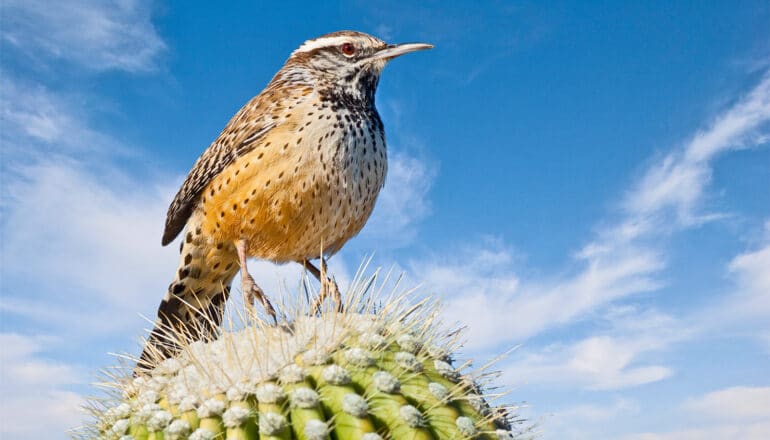Few bird species can escape climate change
- A new study finds that few bird species can escape the effects of climate change due to their inability to relocate quickly enough or far enough.
- The study analyzed data on the movements of 406 North American bird species and found that, on average, birds relocated between 40-50 miles northward during summer months to avoid temperature increases, but still experienced a significant warming of 1.35°C (2.43°F).
- Some bird species, like the cactus wren, did not move at all in response to warming temperatures, making them more susceptible to climate-triggered changes to their environmental niches.
- Birds that are capable of flying long distances were more successful in limiting their exposure to warmer climates and retaining their historic climatic niches, but even these birds are dealing with temperatures exceeding those they knew 20 years ago.
- The study highlights the need for a better understanding and management of climate change’s impact on less mobile species and lesser-known species, which may be unable to persist in a warmer world due to their limited ability to relocate.

While birds are better able than most species to relocate in response to climate change, the environment is changing faster than they can fly, a new study finds.
As rising global temperatures alter ecosystems worldwide, animal species usually have two choices: adapt to changing local conditions or flee to a cooler clime.
Ecologists have long assumed that the world’s bird species were best equipped to respond to the pressures of climate change simply because they have the option of flying to higher altitudes or towards global poles.
But a new study finds that few bird species are able to escape the realities of a warming world.
The findings appear in the journal Nature Ecology and Evolution.
“They can’t move fast enough or far enough to keep up with how quickly climate change is occurring,” says Jeremy Cohen, the study’s lead author. He is an associate research scientist in Yale University’s ecology and evolutionary biology department of and member of the lab of coauthor Walter Jetz.
Jetz, a professor of ecology and evolutionary biology, is also director of the Yale Center for Biodiversity and Global Change and a chair of the EO Wilson Biodiversity Foundation.
For the study, Cohen and Jetz analyzed data on the movements of 406 species of North American birds collected from citizen observers over two decades as well as corresponding local temperature changes. They found that many of the assumptions they’d made about how bird species are responding the climate change were correct.
During summer, for instance, bird species on average relocated between 40 and 50 miles northward during the period covered in the data—and sometimes relocated to higher elevations. And, on average, the northbound movement helped birds avoid a temperature increase of about 1.28 degrees Celsius (2.3 degrees Fahrenheit)—or about half of the temperature increase they would have experienced if they stayed put.
But, on average, birds still experienced a 1.35-degree Celsius (2.43 degrees Fahrenheit) increase in temperature during the summer months compared with temperatures in their original home range. During winter months, birds had only minimal success in limiting their exposure to warming, experiencing only 11% less warming than had they not moved. In winter, birds experienced on average a whopping 3.7-degree Celsius (6.66 degrees Fahrenheit) increase in temperatures over the 20 years, reducing their potential exposure only by half a degree via their movement north.
Birds’ ability to escape higher temperatures also varied by species. Overall, more than 75% of birds managed to reach slightly cooler climes in response to warming temperatures. But some species, like the cactus wren, which is native to deserts and arid systems in North America, did not move at all, making them more susceptible to climate-triggered changes to their environmental niches.
These so-called climatic “niche shifters” could be limited in flight capability or prevented from leaving their current home environment or competing for them in new locations by specific fine-scale habitat needs and ecological dependencies.
Bird species capable of flying long distances were the most successful in limiting their exposure to warmer climates and retaining their historic climatic niches, the researchers found. This included the blue-winged warbler, which traveled more than 100 miles northward and experienced two fewer degrees of warming than if it had stayed put. But even these birds are dealing with temperatures that exceed those they’d known in their original home range 20 years ago.
For species that are far less mobile than birds, such as reptiles and mammals, the options for escaping the rapid warming are even more limited.
Climate change is expanding the gap between the climatic niche species have evolved into over thousands of years and what they experience in their home grounds, the authors say.
“In a uniquely well-studied continental system, we find that even a highly mobile group, such as birds, is unable to relocate quickly enough to keep up with this velocity,” Jetz says
“This raises deep concerns about the ability of all the other, less mobile species and lesser known species to persist in a warmer world. A much better understanding and management of most likely climate change victims—those most ecologically and geographically tied down—is needed to fend off an impending extinction crisis.”
Funding for the study came, in part, from the EO Wilson Biodiversity Foundation in furtherance of the Half-Earth Project.
Source: Yale
The post Few bird species can escape climate change appeared first on Futurity.
